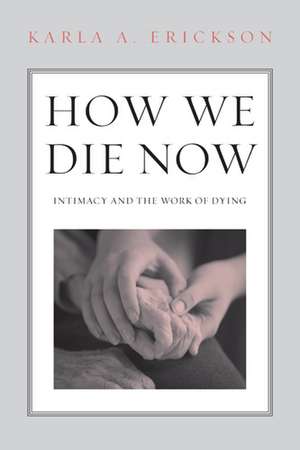How We Die Now: Intimacy and the Work of Dying
Autor Karla Ericksonen Limba Engleză Hardback – 26 sep 2013
As we live longer and die slower and differently than our ancestors, we have come to rely more and more on end-of-life caregivers. These workers navigate a changing landscape of old age and death that many of us have little preparation to encounter. How We Die Now is an absorbing and sensitive investigation of end-of-life issues from the perspectives of patients, relatives, medical professionals, and support staff.
Karla Erickson immersed herself in the daily life of workers and elders in a Midwestern community for over two years to explore important questions around the theme of “how we die now.” She moves readers through and beyond the many fears that attend the social condition of old age and reveals the pleasures of living longer and the costs of slower, sometimes senseless ways of dying.
For all of us who are grappling with the “elder boom,” How We Die Now offers new ways of thinking about our longer lives.
Preț: 560.62 lei
Preț vechi: 623.01 lei
-10% Nou
Puncte Express: 841
Preț estimativ în valută:
107.28€ • 111.37$ • 89.46£
107.28€ • 111.37$ • 89.46£
Carte indisponibilă temporar
Doresc să fiu notificat când acest titlu va fi disponibil:
Se trimite...
Preluare comenzi: 021 569.72.76
Specificații
ISBN-13: 9781439908235
ISBN-10: 1439908230
Pagini: 212
Dimensiuni: 140 x 210 x 18 mm
Greutate: 0.34 kg
Editura: Temple University Press
Colecția Temple University Press
ISBN-10: 1439908230
Pagini: 212
Dimensiuni: 140 x 210 x 18 mm
Greutate: 0.34 kg
Editura: Temple University Press
Colecția Temple University Press
Notă biografică
Karla A. Erickson is Associate Professor in the Department of Sociology at Grinnell College. She is the author of The Hungry Cowboy: Service and Community in a Neighborhood Restaurant and co-editor (with Jennifer Pierce and Hokulani Aikau) of Feminist Waves, Feminist Generations, Life Stories from the Academy, 1964-2000.
Cuprins
Acknowledgments
1 How We Die Now: Americans Aging and Dying in the Twenty-First Century
2 The Paradox of Long-Term Care: We Need It; We Fear It
3 Transitioning Together: Living, Working, Aging, and Dying at Winthrop House
4 Lessons from the End of Life: What Workers Learn from Helping Others Die
5 Mutual Interdependency: Belonging, Recognition, and the Rewards of Caring for One Another
Afterword
Glossary
References
Index
